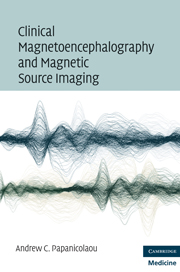Book contents
- Frontmatter
- Contents
- Contributors
- Preface
- Section 1 The method
- Section 2 Spontaneous brain activity
- Section 3 Evoked magnetic fields
- 19 Recording evoked magnetic fields (EMFs)
- 20 Somatosensory evoked fields (SEFs)
- 21 Movement-related magnetic fields (MRFs) – motor evoked fields (MEFs)
- 22 Auditory evoked magnetic fields (AEFs)
- 23 Visual evoked magnetic fields (VEFs)
- 24 Language-related brain magnetic fields (LRFs)
- 25 Alternative techniques for evoked magnetic field data – future directions
- Postscript: Future applications of clinical MEG
- References
- Index
21 - Movement-related magnetic fields (MRFs) – motor evoked fields (MEFs)
from Section 3 - Evoked magnetic fields
Published online by Cambridge University Press: 01 March 2010
- Frontmatter
- Contents
- Contributors
- Preface
- Section 1 The method
- Section 2 Spontaneous brain activity
- Section 3 Evoked magnetic fields
- 19 Recording evoked magnetic fields (EMFs)
- 20 Somatosensory evoked fields (SEFs)
- 21 Movement-related magnetic fields (MRFs) – motor evoked fields (MEFs)
- 22 Auditory evoked magnetic fields (AEFs)
- 23 Visual evoked magnetic fields (VEFs)
- 24 Language-related brain magnetic fields (LRFs)
- 25 Alternative techniques for evoked magnetic field data – future directions
- Postscript: Future applications of clinical MEG
- References
- Index
Summary
Overview of MRFs
Magnetic fields preceding voluntary movements are generated by neurons oriented tangential to the scalp in motor cortex contralateral to the limb moved. MRFs can be recorded and their intracranial sources localized with much greater fidelity and reliability than movement-related potentials. The location of MRF sources in the anterior wall of the central sulcus has been con- firmed in several studies through direct comparisons with the results of direct electrocortical-stimulation mapping.
MRFs are used clinically to localize the central sulcus and the somatotopic organization of the primary motor cortex or to evaluate motor function in patients with either organic or functional brain diseases before surgical interventions such as craniotomy, stereotactic, or radiosurgical procedures, and/or with suspected abnormalities in the descending corticospinal pathways.
Recording MRFs
Elicitation
Extension of the index finger is most commonly used for eliciting MRFs. Extension of the entire hand may also be used. Movement can be self-paced or externally cued. During a self-paced recording session, the patient lies supine, hand at his/her side resting on a nonmagnetic pad, and is asked to briskly flex the index finger at a rate of approximately one movement every 3 to 5 seconds (see Fig. 21.1). In the context of externally cued procedures, the patient is asked to react by pushing a button or performing hand extension as quickly as possible to a visual or tactile cue that is presented every 2 to 3 seconds. At most centers, somatosensory and motormapping are performed in separate sessions.
- Type
- Chapter
- Information
- Clinical Magnetoencephalography and Magnetic Source Imaging , pp. 128 - 133Publisher: Cambridge University PressPrint publication year: 2009



